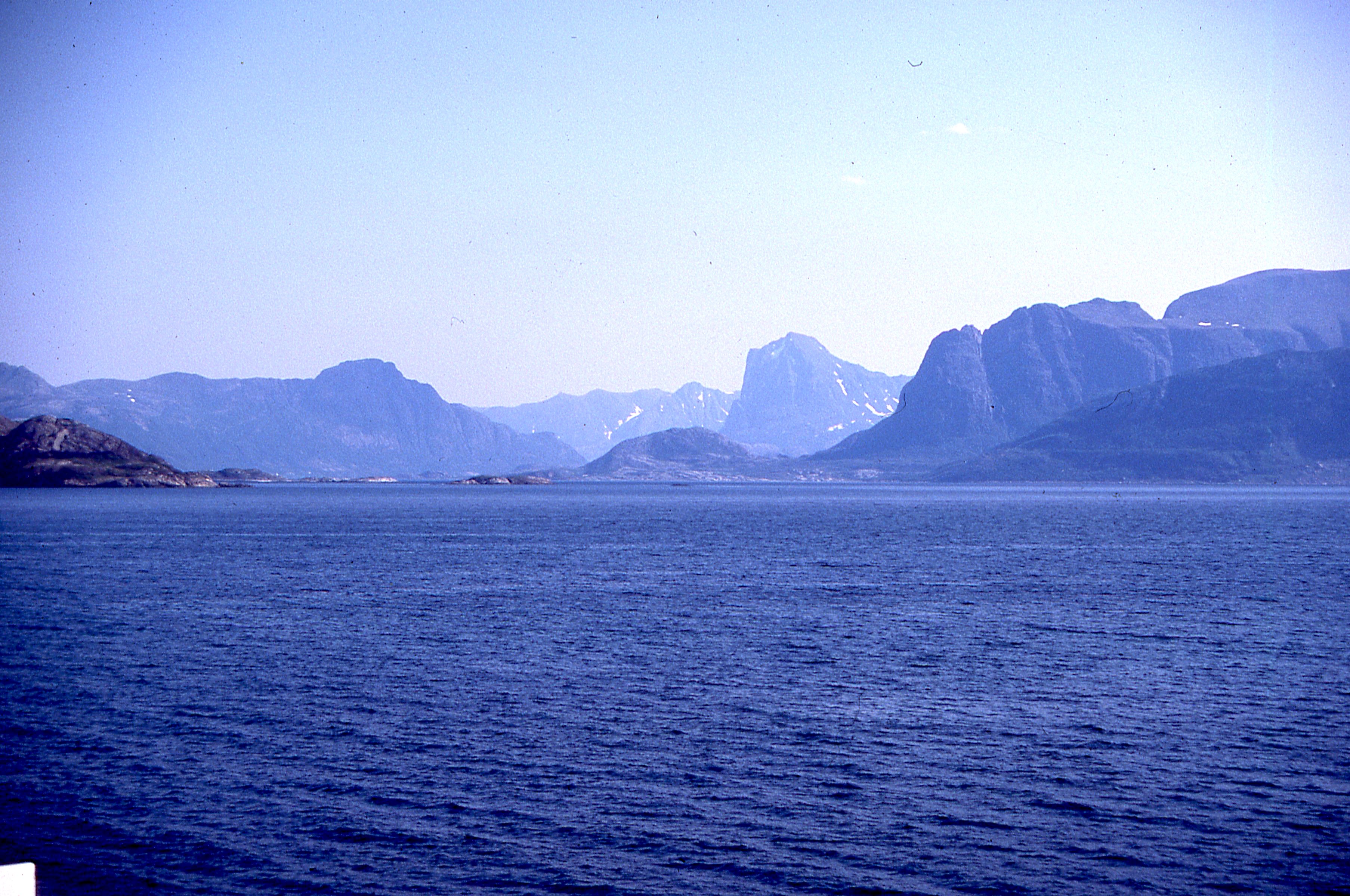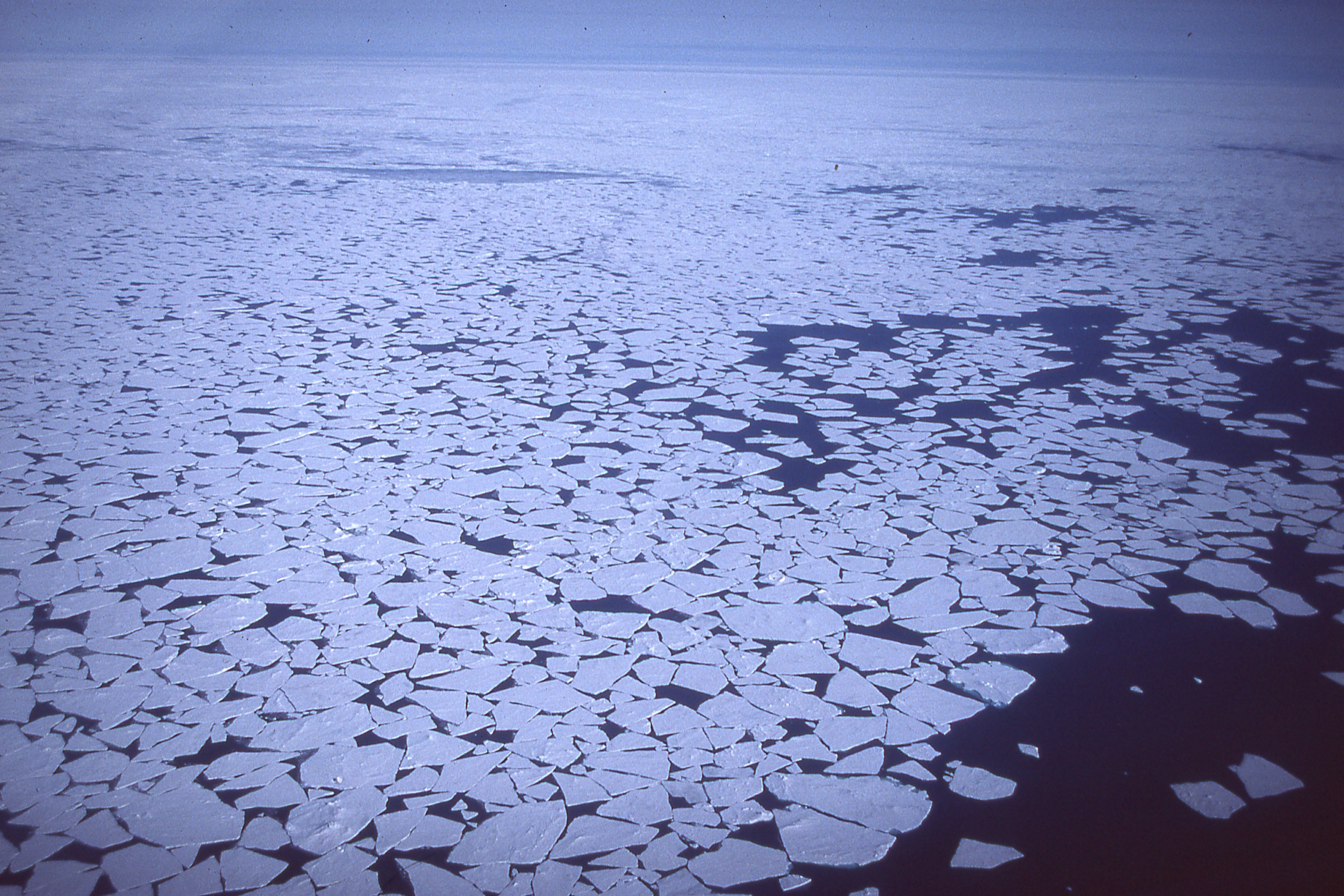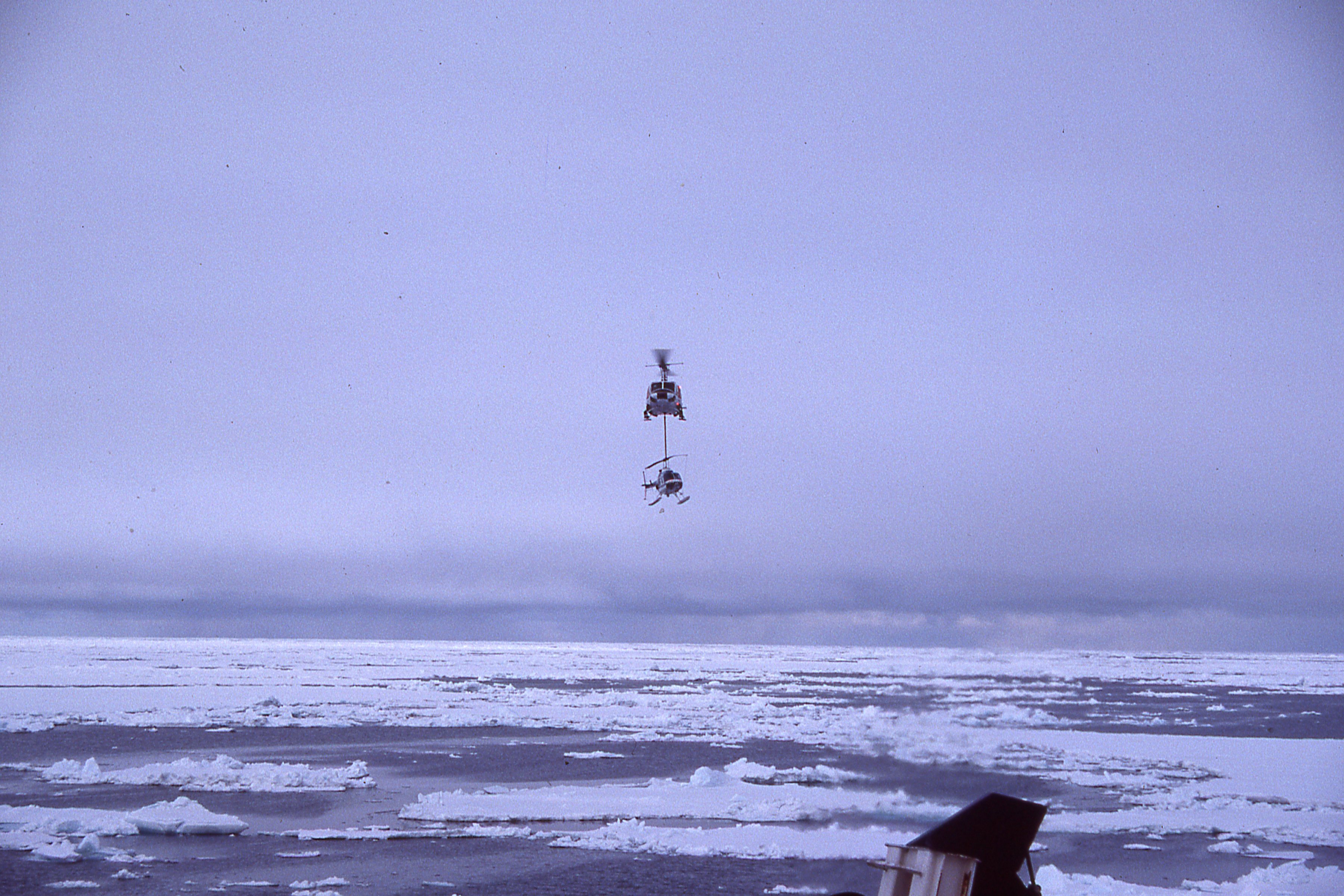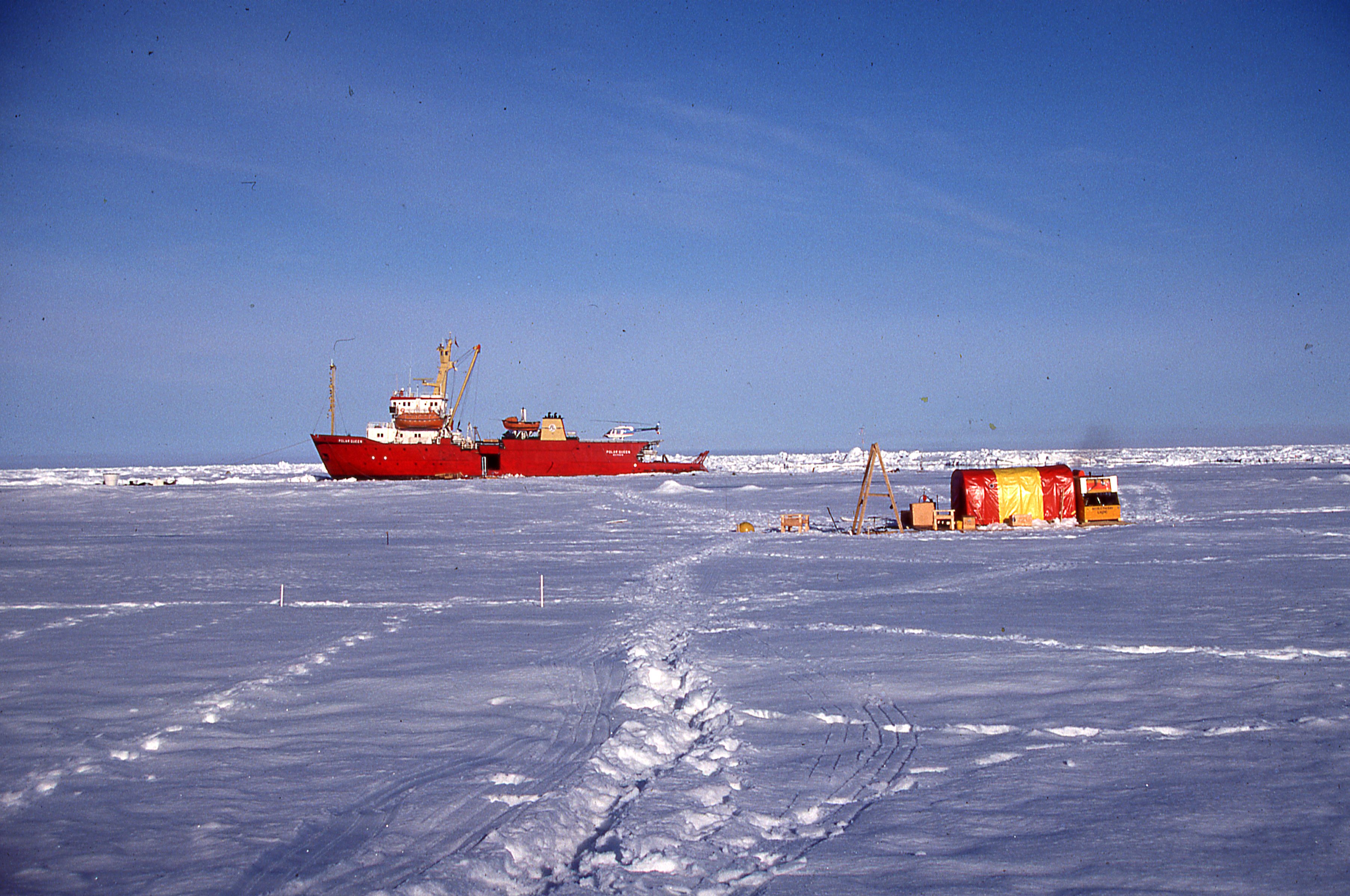Marginal Ice Zone Experiment (MIZEX) 1984
Location and Duration
Drift Stations from the R/V Polarqueen in the
Marginal Ice Zone of the Arctic Ocean/Greenland Sea
1 Jun 1984 to 30 Jul 1984
Central Arctic (Representative
photographs
here)
Background
MIZEX84 became a defining pivot in my career. After leaving CRREL, but after deciding to return to science, I was asked by Leonard Johnson, ONR Program Manager, to occupy the Arctic Chair at the Naval Postraduate School in Monterey for the 1982-83 academic year. From that position, I was named the US coordinator and Vice-Chair for the Maraginal Ice Zone Experiment (MIZEX). Under the overall scientific leadership of Ola Johannesen, University of Bergen, the plan was to launch a limited pilot study (one vessel, R/V Polarbjorn) in the summer of 1983, as a dry run for the major summer experiment in 1984. The main MIZEX experiment was a major international undertaking, with scientists from Norway, Germany, France, Great Britain, and the US, supported by four oceanographic research vessels and numerous aircraft. During planning sessions in Bergen, Bremerhaven, Washington DC, Cambridge, MA, and Monterey (I traveled a lot that year!), a detailed plan for the 1984 field project was formulated. My role was to serve as Chief Scientist aboard the chartered Norwegian research vessel M/V Polar Queen, for which the primary task would be drifting with the ice to measure air-ice-ocean interaction.
We gathered in Bergen in late May to finalize plans, monitor ice
conditions by satellite imagery, buy last minute supplies and pack all
the science
 gear in the Polar Queen's hold. There was press coverage and
delightful spring weather with almost constant daylight. Finally
underway in the evening of
May 31, 1984, fair weather continued as we sailed up the inland passage
along the west coast of Norway, with spectacular scenery for the entire
trip north to Tromso, arriving there on Jun 2. After a "traditional
polar expedition" sendoff dinner at the Pepper Mullen (where Amundsen was
reported to have eaten
gear in the Polar Queen's hold. There was press coverage and
delightful spring weather with almost constant daylight. Finally
underway in the evening of
May 31, 1984, fair weather continued as we sailed up the inland passage
along the west coast of Norway, with spectacular scenery for the entire
trip north to Tromso, arriving there on Jun 2. After a "traditional
polar expedition" sendoff dinner at the Pepper Mullen (where Amundsen was
reported to have eaten
 his last meal before leaving on the fateful search for Nobile), we departed early
the next morning for the ice, watching as water skiers enjoyed smooth
waters on the fjord.
his last meal before leaving on the fateful search for Nobile), we departed early
the next morning for the ice, watching as water skiers enjoyed smooth
waters on the fjord.
The Experiment
As we approached the MIZ, I did a helicopter scouting mission to look
for a floe to which we could moor the ship. The prospect was not good.
Wind had been blowing
 from the north for some time opening a diffuse ice pack boundary,
already broken up in to small floes by ocean swell. We continued
searching until we found a
floe that barely met the criteria we had discussed, moored the
Polarqueen and proceed to set up the various on-ice experiments
including my instrument mast and Jamie Morison's profiler. The floe
continued to move south in response to northerly wind, and after a while
we began noting that the floe was rotating rapidly. For us standing on the
ice surface with low clouds concealing the sun, the rotation was not so
obvious, but it was driving our instruments crazy.
from the north for some time opening a diffuse ice pack boundary,
already broken up in to small floes by ocean swell. We continued
searching until we found a
floe that barely met the criteria we had discussed, moored the
Polarqueen and proceed to set up the various on-ice experiments
including my instrument mast and Jamie Morison's profiler. The floe
continued to move south in response to northerly wind, and after a while
we began noting that the floe was rotating rapidly. For us standing on the
ice surface with low clouds concealing the sun, the rotation was not so
obvious, but it was driving our instruments crazy.
In the meantime, we continued to deploy buoys at locations away from
the ship via helicopter. During one such deployment, both helos were out
when we got a message that one was down on the ice with a blown turbojet
engine. Fortunately, we had the second aircraft so the crew and passengers
were in no danger. We were also
 close enough to Svalbard that the much larger Sysselmann's Bell 212
helo could fly out to airlift the damaged aircraft back to the ship, where
a new turbojet was installed overnight.
close enough to Svalbard that the much larger Sysselmann's Bell 212
helo could fly out to airlift the damaged aircraft back to the ship, where
a new turbojet was installed overnight.
After a few days with the ice around us deteriorating, and the rotation problem becoming more acute, we held a science meeting and by consensus decided it was time to pull up stakes and search for better conditions. With the first deployment pretty much a debacle, I sensed that there weren't going to be many more chances to find a suitable floe.
I had already worked closely with Captain Acklestad, which was a real pleasure. On several occasions, he invited me to join him in the crowsnest atop the mast on the foredeck, where he controlled the ship via joystick. Maneuvering in old floes with an underpowered vessel required great skill, and Aklestad excelled. Ater observing for a while I realized that for him it was like a chess game: he was always thinking ahead to the fourth or fifth floe, rather than just getting around what was in front of us.
By the time we recovered the first deployment, the northerly winds that had dispersed the ice had abated. During discussions at the daily PI meeting, I suggested a target location quite a bit farther into the pack. I asked Arne Hansen, who had spent a fair amount of time on pack ice, to accommpany me on a helicopter flight to look for a floe that might survive until the end of July. We took off for the target, flying over mostly questionable ice, landing on a couple to measure thickness and floe dimenions. As we approached the target location, my excitement rose; there it was: a broud, roughly circular flow, supporting a gleaming white snow cover with decent freeboard. I knew even before we landed, at almost exactly the target coordinates, that this was our new home. We returned, gave Captain Aklestad the coordinates and headed there.
Once on site, Jay Ardai and I got off the ship to locate the best
mooring site along the floe edge. We were communicating with the bridge,
and discussed the problem that we often face when operating from an open
port on the side of the ship. It is difficult and time consuming to hack
out a hydrohole at the edge of both the floe and
 the ship. Aklestad told us he would take care of it. So he backed
the ship off, turned the bow directly at Jay and me standing on the floe,
and applied full power. We stood
there, dumbfounded as this huge object bore down on us approaching full
speed. It of course stopped suddenly when it struck the floe edge, but
all Jay and I could do was laugh hysterically, so hard that we had to
sit down on the snow. When we did get up and the ship had backed off,
there is was: a notch in the ice in the shape of the bow that was a
perfect hydrohole for the ship based profiling system.
the ship. Aklestad told us he would take care of it. So he backed
the ship off, turned the bow directly at Jay and me standing on the floe,
and applied full power. We stood
there, dumbfounded as this huge object bore down on us approaching full
speed. It of course stopped suddenly when it struck the floe edge, but
all Jay and I could do was laugh hysterically, so hard that we had to
sit down on the snow. When we did get up and the ship had backed off,
there is was: a notch in the ice in the shape of the bow that was a
perfect hydrohole for the ship based profiling system.
We redeployed and settled into the intense measurement routine that we
had envisioned in the planning process. For me, the schedule was
somewhat grueling. I worked closely with a group under Jamie Morison
from the University of Washington Polar Science Center. That included
Pat McKeown, who was paid from my grant and hence
 worked primarily for me. We operated 24 hours, as did Jamie with his
profiling system, and by close cooperation were able to keep things
covered. But I also had chief scientist responsibilities, which
entailed twice daily "radiocomms" with the overall chair (Johanessen)
and other chief scientists during which updates from each platform
were given and discussed. These were scheduled for 5am and 5pm, which
was difficult for me, since I was often up late taking care of other
problems (besides my own, somewhat ambitious science project)
including helo and snowmobile scheduling, and pther resource
allocation. After a crew exchange about midway through the experiment,
Andy Heiberg joined us aboard and took over many of the more difficult
tasks like working out the helicopter scheduling and tracking under a
load of competing requests. One of
worked primarily for me. We operated 24 hours, as did Jamie with his
profiling system, and by close cooperation were able to keep things
covered. But I also had chief scientist responsibilities, which
entailed twice daily "radiocomms" with the overall chair (Johanessen)
and other chief scientists during which updates from each platform
were given and discussed. These were scheduled for 5am and 5pm, which
was difficult for me, since I was often up late taking care of other
problems (besides my own, somewhat ambitious science project)
including helo and snowmobile scheduling, and pther resource
allocation. After a crew exchange about midway through the experiment,
Andy Heiberg joined us aboard and took over many of the more difficult
tasks like working out the helicopter scheduling and tracking under a
load of competing requests. One of
 our common concerns was the ubiquitous presence of polar bears, who
were as interested as we in occupying the marginal ice zone, because
typically that's where seals congregate. It seemed that we had new
visitors almost every day, and we made sure no one got far from the
ship without a flare pistol and firearm. Sometimes they provided a
nice break to the routine. One evening, Jamie expressed impatience
with a young bear that had been hanging about all day, and suggested
the three of us go scare him off. The flares we used had little
parachutes that were supposed to drop from air near the bear. We all
fired off our flares, but as the parachutes deployed, the wind from
behind us carried the blazing flares past the bear, so that now he was
between us and the fire. He hesitated for a moment, then apparently
decided that the fire posed less danger than the three strange objects
in bright orange deck suits advancing, and ran away past the flares.
Whenever a more formidable bear stayed around too long, we would ask
the helo pilots to scare them off. Overall, the bears didn't pose much
of a problem, as they were probably well fed.
our common concerns was the ubiquitous presence of polar bears, who
were as interested as we in occupying the marginal ice zone, because
typically that's where seals congregate. It seemed that we had new
visitors almost every day, and we made sure no one got far from the
ship without a flare pistol and firearm. Sometimes they provided a
nice break to the routine. One evening, Jamie expressed impatience
with a young bear that had been hanging about all day, and suggested
the three of us go scare him off. The flares we used had little
parachutes that were supposed to drop from air near the bear. We all
fired off our flares, but as the parachutes deployed, the wind from
behind us carried the blazing flares past the bear, so that now he was
between us and the fire. He hesitated for a moment, then apparently
decided that the fire posed less danger than the three strange objects
in bright orange deck suits advancing, and ran away past the flares.
Whenever a more formidable bear stayed around too long, we would ask
the helo pilots to scare them off. Overall, the bears didn't pose much
of a problem, as they were probably well fed.
In general, the science complement aboard the PolarQueen was a remarkably experienced and dedicated group. Our relationship with the Norwegian crew aboard was also outstanding. They were enthusiastic about what we were doing and always willing to help. That said, there were times when I had to earn my keep for occupying the relatively plush CS cabin. Often this involved minor differences over resource allocation such as helicopter or snowmobile usage. One particularly vexing case involved a particular PI whom we had invited to participate (and who obtained ONR funding on that basis) because his institution had one of the only high quality CTD systems available, something we thought critical to a successful program. Since we were operating in an ocean environment with potentially large horizontas gradients, we had stressed in planning the importance of frequent sampling, i.e., obtaining ocean profiles several times a day, four at a minimum, to estimate inertial or tidal variability. After we had the station operational, he informed me that he would not perform more than one station per day. Despite consensus among the other ocean group, that once a day was not sufficient, he persisted. Finally, I asked CS Johannessen to speak with him at one of our radiocomm sessions, to no avail, and eventually I called our program manager at ONR in Arlington, Virginia, via radiotelephone to see if he could encourage him. It took way more calls and time than it should have, and he never did adhere to what we thought was a reasonable sampling schedule. As it turned out, Morison's profiler filled in most of the gap, albeit at shallower depths.
One other PI required an inordinate amount of logistic support including manpower from other projects,
and in fact one of his installation failures managed to disrupt the amazing
 Fourth of July feast our Norwegian cook had spent hours preparing.
Fourth of July feast our Norwegian cook had spent hours preparing.
We drifted south for some time in near surface water that was slightly above freezing during which we measured modest heat flux. Then, rather abruptly, the wind blew us over water that was as much as 1 degree above freezing. The combination of significant stress and large thermal forcing generated large heat fluxes, at least an order of magnitude greater than we had seen before. In some respects, this "made" the experiment, providing enough of a range of conditions to make credible estimates of the thermal exchange coefficient. The values we reported became de-facto standards. We later learned that the background conditions had changed when we drifted over a warm eddy that had formed near the ice edge.
After we had drifted onto the eddy and as we approached the end of our time on the ice, the floe surface that had been absorbing shortwave radiation for weeks
became a bog of melt
areas and slush. One morning as I left the ship, I was surprised to find that overnight the surface water had disappeared leaving a relatively dry surface of fairly large
ice crystals. We surmised that heat migrating from upper and lower surfaces had finally warmed ice thoughout the entire column to its melting temperature,
eliminating the last
 horizontal ice layer resisting drainage of liquid above that level. When that happened, all of the fresh water from the surface and from voids in the ice
column flushed into the upper ocean. At the time, winds were calm and there was little turbulence in the upper ocean to mix the fresh inflow downward. Our instruments
confirmed that water just below the ice had become much fresher and remained warm. Then, on literally the last day that we could make measurements in the
scheduled drift phase of the experiment, the wind started to pick up. We expected that the ice would respond by drifting rapidly, since the underlying boundary was
stable, reducing drag. Instead the response was sluggish. I was familiar with Ekman's description of increased drag on ships in stratified fjords, when they
generated large internal waves on the boundary between fresh surface water and underlying saline water. I suspected a similar phenomenon was slowing the ice
drift, an interpretation bolstered by direct observation of waves in our current meter records. We were later able to show that a significant fraction
of the momentum imparted by the wind went directly to generation of internal waves, significantly reducing near surface turbulent mixing. We also later
learned that by the time we pulled our instruments off the ice in order to maintain the tight schedule, the ice had probably been approaching the speed
at which it would "outrun its wake." Alas, just a few more hours of measurements would have been very valuable.
horizontal ice layer resisting drainage of liquid above that level. When that happened, all of the fresh water from the surface and from voids in the ice
column flushed into the upper ocean. At the time, winds were calm and there was little turbulence in the upper ocean to mix the fresh inflow downward. Our instruments
confirmed that water just below the ice had become much fresher and remained warm. Then, on literally the last day that we could make measurements in the
scheduled drift phase of the experiment, the wind started to pick up. We expected that the ice would respond by drifting rapidly, since the underlying boundary was
stable, reducing drag. Instead the response was sluggish. I was familiar with Ekman's description of increased drag on ships in stratified fjords, when they
generated large internal waves on the boundary between fresh surface water and underlying saline water. I suspected a similar phenomenon was slowing the ice
drift, an interpretation bolstered by direct observation of waves in our current meter records. We were later able to show that a significant fraction
of the momentum imparted by the wind went directly to generation of internal waves, significantly reducing near surface turbulent mixing. We also later
learned that by the time we pulled our instruments off the ice in order to maintain the tight schedule, the ice had probably been approaching the speed
at which it would "outrun its wake." Alas, just a few more hours of measurements would have been very valuable.
Ending the drift phase was not the end of the our experiment. We still had buoys amd moorings to retrieve, which was greatly hindered when intermittent fog settled in over our region. In one instance, we drove to the coordinates of a mooring that had been deployed at the start of the experiment. The bottom acoustic release was triggered, but the floats that should have brought it to the surface were nowhere in sight. We searched for hours, constantly checking our satellite positions. Finally, Captain Aklestad spotted the floats and the mooring was retrieved, which was great relief to me since I really, really didn't want to lose Ken Hunkin's mooring, since I knew I would never hear the end of it.
Another much more serious event also transpired during these final days. We were at the time operating near the Prime Meridian. We had received a position for a French listening buoy, with the longitude reported as positive, meaning east of the Prime. The position was not too far from where we were, and we planned to retrieve the buoy the next day with short helo flights. When we received the buoy position by radio the next morning, the position was now reported as negative (W) longitude. Suddenly the distance the helicopters would have to fly had increased significantly, and meant there would be a much longer weather window in which they would have to operate. Both took off to effect the recovery. As we waited for them to return, a heavy fog settled in around the ship. Now we were in crisis: helicopters are extremely difficult to fly in fog. The pilots would have to fly close to the water for visibility, and would have difficulty finding the ship, especially operating with limited fuel. Fortuitously, one of the science projects had used X-band radar to track ice positions, and the helos were equipped with the transponders that could respond to that frequency. The system provided positions at a much higher rate than the ship's radar. Much to his credit, Jay Ardai was able improvise a tracking system to locate the helos when they got within radar range and get them positioned aft of the ship. He then guided them slowly to the helo deck. Although we could hear them, they did not appear out of the fog until they were almost to the fantail. They landed safely, mission accomplished, but I didn't fail to notice that one pilot's hands were shaking visibly. Whew!
We had one more exchange of data and equipment with the Kvitbjorn, then headed for Tromso. Unfortunately, we left the ice in the
teeth of a strong North
Atlantic storm with 25 foot seas. Everyone but the captain and mate were sick; some of the longest 48 hours I have ever spent! Finally, we
reached the calm
waters of the fjord leading to Tromsø, and I regained my composure enough to greet Saundie at the dock. She got aboard, became a welcome fixture on the bridge,
and shared the CS cabin with me on the trip back
 down the inside passage to Bergen. There ere we began an auto tour of Norway, starting with a couple of days at Ole Johanessen's cabin
in Voss, ending in Copenhagen where we celebrated my 38th birthday in Tivoli Garden. Great way to end a project.
down the inside passage to Bergen. There ere we began an auto tour of Norway, starting with a couple of days at Ole Johanessen's cabin
in Voss, ending in Copenhagen where we celebrated my 38th birthday in Tivoli Garden. Great way to end a project.